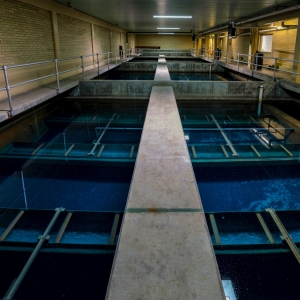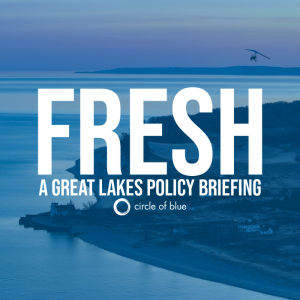Federal Water Tap, October 2: Federal Commission Identifies Needs for Protecting Water from Wildfire Damage
The Rundown
- A federal wildfire commission highlights the need to protect water supplies from high-severity fires.
- The White House issues a disaster declaration for saltwater intrusion in Louisiana.
- GAO report details earmark spending in fiscal year 2023.
- EPA allocates funds to train workers for water sector jobs.
- EPA watchdog questions the agency’s handling of Great Lakes restoration grants.
- NOAA awards a contract for improved national flood modeling and mapping.
- USGS study investigates road salt in groundwater in southern Oregon.
- The White House releases a National Climate Resilience Framework.
- President Biden calls for a national effort to protect Columbia River basin salmon.
And lastly, a Department of Energy official speaks about carbon capture technology.
“We’re not going to succeed at meeting this climate challenge if we don’t do it in ways that work for people in places like Wyoming and North Dakota.” — Brad Crabtree, assistant secretary for fossil energy and carbon management, speaking at Decarbonizing the West, an initiative of Wyoming Gov. Mark Gordon. Crabtree praised Gordon for his approach to “reframe the climate challenge” to make it about technologies like carbon capture that could allow fossil fuel energies to continue to operate, but without putting heat-trapping gases into the atmosphere.
In context: Removing Carbon from Air, Which Increases Water Use, Is No Simple Climate Fix
By the Numbers
$20.8 Million: EPA grant funding to support worker training in the water sector. Eligible organizations — nonprofit groups, educational institutions, public works agencies — must apply by November 17.
$2.8 Billion: Earmarks in the fiscal year 2023 budget for watersheds and water infrastructure, according to a GAO report. The water infrastructure earmarks were subtracted from state revolving fund allocations. Water industry groups worry that this practice jeopardizes the future of the revolving funds, which are a low-interest means of financing water projects.
News Briefs
Saltwater intrusion Disaster Declaration
The White House officially issued a disaster declaration for four Louisiana parishes that are contending with saltwater intrusion in the Mississippi River.
The disaster declaration for Jefferson, Orleans, Plaquemines, and St. Bernard parishes means that local governments are eligible for federal funds to respond to the emergency.
Columbia River Basin Salmon
In a memo to federal agencies, President Biden called for a “sustained national effort” to protect salmon and other native fish species in the Columbia River basin.
What does that mean? It is an administration policy to operate federal dams in the Columbia basin so that fish and wildlife have “equitable treatment” with power generation, flood protection, and other authorized purposes. Salmon runs have been decimated in the basin in the last century due to dams, warming temperatures, and pollution.
To achieve this, the administration pledges to work with the basin’s tribes and state and local governments. Due to on-going litigation, dam operations in recent years have been adjusted to be less lethal to salmon. One big question that Congress is grappling with: whether to breach four dams on the lower Snake River.
East Palestine Train Derailment Aftermath
President Joe Biden issued an executive order stating that holding Norfolk Southern “fully accountable under the law” for a February 2023 train derailment is an administration priority.
The derailment in East Palestine, Ohio, spilled toxic chemicals into air, land, and water.
Studies and Reports
Wildfire and Water
A federal wildfire commission submitted a report to Congress recommending new approaches to addressing the risk of catastrophic fire.
The Wildland Fire Mitigation and Management Commission, established by Congress in 2021, reiterates that protecting water supplies from high-severity fires is critical. Fires can introduce contaminants into drinking water pipes. Erosion, sediment, and debris complicates water treatment and endangers reservoirs, pumps, and treatment equipment.
The commission makes several recommendations in this regard: expedite funding for water utilities in fire-affected areas, prioritize watershed protection as part of wildfire mitigation projects, and help local agencies with post-fire drinking water testing.
In context: In New Mexico, Partners Collaborate to End Siege from Megafires
Managing Great Lakes Grants
The EPA’s watchdog says the agency is not following federal requirements when it distributes grants for Great Lakes Restoration Initiative projects.
The GLRI is a federal initiative that has provided $3.2 billion in grants since its inception in 2010.
The Office of the Inspector General report notes that the EPA did not adequately track costs or keep records. The agency is taking action to correct its procedures.
Road Salt
A U.S. Geological Survey study found increasing chloride levels in shallow groundwater near a mountain pass in southern Oregon where salts are applied in winter to keep the road from freezing.
In context: Road Salt, a Stealthy Pollutant, Is Damaging Michigan Waters
Flood Forecasting and Mapping
The Department of Commerce awarded an $80 million contract to Raytheon to develop flood forecasting models and “near real-time” maps of flooded areas.
Climate Resilience
The White House released its National Climate Resilience Framework, a document that describes opportunities for the federal government — via codes and standards, land management, financing, nature-based solutions, and technical assistance — to assist the nation in reducing damage from a warming planet.
On the Radar
Shutdown Averted (Delayed?)
Congress passed a last-minute continuing resolution that keeps the federal government operating through November 17.
The resolution extends agency funding at current levels.
Environmental Finance Advisory Board Meeting
The group that advises the EPA on how to pay for environmental improvements will hold a public meeting on October 24-25 to discuss these issues in the Great Lakes region.
Held in-person in Ann Arbor, Michigan, the meeting also has options to attend virtually. Register here.
Pumped Storage Facility in Arizona
Federal energy regulators are considering granting a preliminary permit to a 150-megawatt pumped storage hydropower project planned for Pinal County, Arizona.
The Ramm Power Group project would be located at a former copper mine and incorporate an existing open-pit mine for the lower of the two reservoirs. It would be a “closed loop” system, meaning no discharge to a stream. A 100-megawatt solar project would be included.
Water for the project would come from the mine and from water rights purchases, according to the FERC filing.
A preliminary permit does not authorize construction; it holds a place in line for submitting a license application.
Federal Water Tap is a weekly digest spotting trends in U.S. government water policy. To get more water news, follow Circle of Blue on Twitter and sign up for our newsletter.
Brett writes about agriculture, energy, infrastructure, and the politics and economics of water in the United States. He also writes the Federal Water Tap, Circle of Blue’s weekly digest of U.S. government water news. He is the winner of two Society of Environmental Journalists reporting awards, one of the top honors in American environmental journalism: first place for explanatory reporting for a series on septic system pollution in the United States(2016) and third place for beat reporting in a small market (2014). He received the Sierra Club’s Distinguished Service Award in 2018. Brett lives in Seattle, where he hikes the mountains and bakes pies. Contact Brett Walton







Leave a Reply
Want to join the discussion?Feel free to contribute!